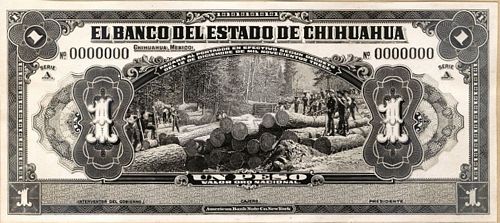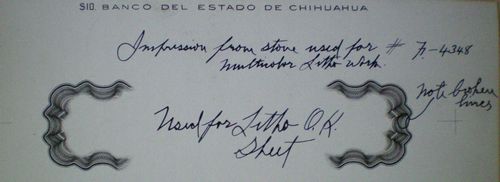Print details for El Banco del Estado de Chihuahua
Bank notes
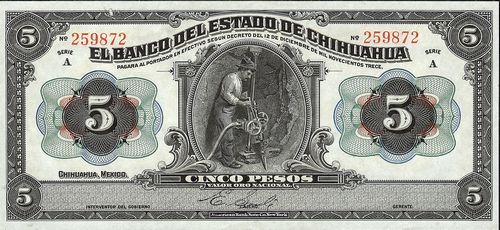
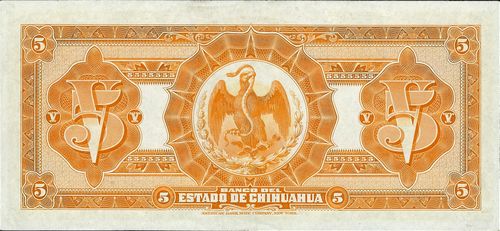 M95a $5 Banco del Estado de Chihuahua
M95a $5 Banco del Estado de Chihuahua
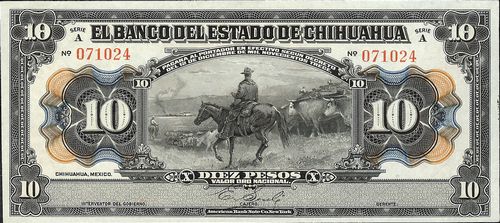
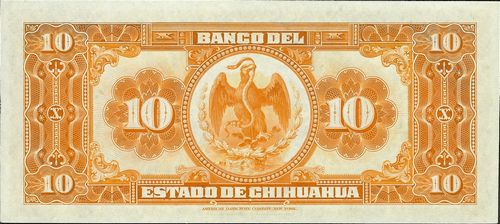 M96a $10 Banco del Estado de Chihuahua
M96a $10 Banco del Estado de Chihuahua
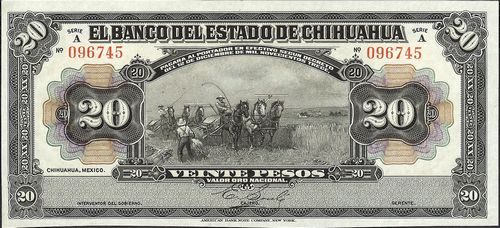
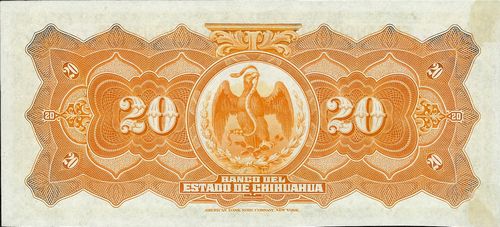 M97a $20 Banco del Estado de Chihuahua
M97a $20 Banco del Estado de Chihuahua
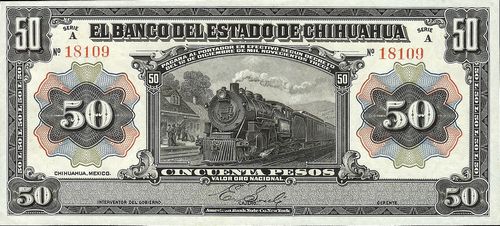
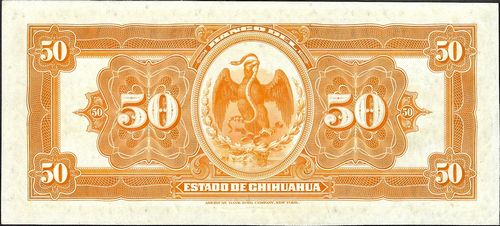 M98a $50 Banco del Estado de Chihuahua
M98a $50 Banco del Estado de Chihuahua
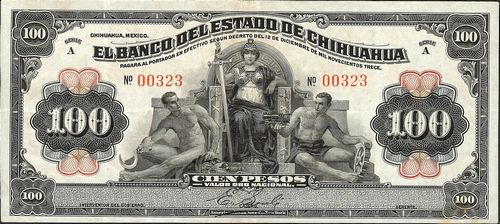
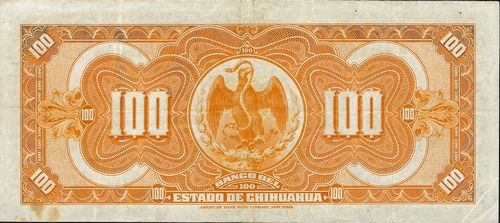 M99a $100 Banco del Estado de Chihuahua
M99a $100 Banco del Estado de Chihuahua
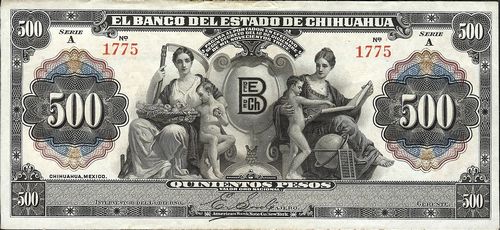
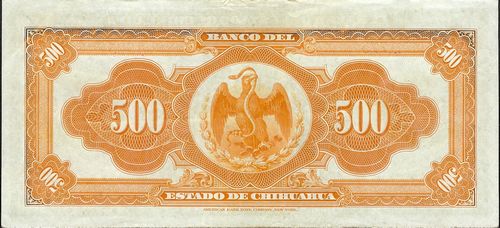 M100a $500 Banco del Estado de Chihuahua
M100a $500 Banco del Estado de Chihuahua
Lázaro de la Garza first contacted the American Bank Note Company when arranging the issue of the dos caritas. On 13 February 1914 de la Garza, from the Hotel Sheldon in El Paso, asked the ABNC for a quote for “500,000, 750,000, 200,000, 150,000; 37,500 and 15,000 notes of 50 cents, 1, 5, 10, 20 and 50 dollar denominations respectively. Numbered progressively. Having in front besides common reading in bank bills two small portraits and on back photograph of building, each denomination a different color, quote price and time delivery on steel plate also transfer to lithography including two secret marks also one signature facsimile. These will be Chihuahua State Treasury bills” but the ABNC replied by telegram, “Greatly regret that we are unable to bid on notes as requested.” In a memorandum the company wrote “Since it is our understanding that the State of Chihuahua is in the hands of the rebels, we of course took it for granted that it was they who wanted the money; and as it is against the principles of our Company to print money, stamps, etc., for a Revolutionary Government, we saw no way out of the matter but to refuse”ABNC papers, folder unnumbered, Banco del Estado de Chihuahua (1914-1939).
In July 1914conjectured date, based on the fact that one note was written on Chihuahua Foreign Club headed paper and that Moye was staying at the Club on 23 July 1914 Federico Moye, the Director General of the bank, made some notes on a proposed issue of 300 million pesos, printed on planchette banknote paper“Planchette paper”, which contained coloured paper discs rather than silk fibres or threads, was introduced by the American Bank Note Company in 1891, with one steel printing on the face and back, and a double litho printing on the face. One suggestionLG papers, 4-B-46 was
| Number | Value | Total | size |
|---|---|---|---|
| 15,0000,000 | $1 | $15,000,000 | 5 x 2¾ inches |
| 9,000,000 | $5 | $45,000,000 | 5½ x 3 inches |
| 6,000,000 | $10 | $60,000,000 | 5½ x 3 inches |
| 3,000,000 | $20 | $60,000,000 | 5½ x 3 inches |
| 1,200,000 | $50 | $60,000,000 | 6 x 3 3/16 inches |
| 600,000 | $100 | $60,000,000 | 6 x 3 3/16 inches |
| 34,800,000 | $300,000,000 |
whilst another, written on CHIHUAHUA FOREIGN CLUB headed paperLG papers, 4-B-47: 4-A-9 was
| Number | Value | Total | size |
|---|---|---|---|
| 9,000,000 | $5 | $45,000,000 | 5½ x 3 inches |
| 6,000,000 | $10 | $60,000,000 | 5½ x 3 inches |
| 3,000,000 | $20 | $60,000,000 | 5½ x 3 inches |
| 1,200,000 | $50 | $60,000,000 | 6 x 3 3/16 inches |
| 600,000 | $100 | $60,000,000 | 6 x 3 3/16 inches |
| 30,000 | $500 | $15,000,000 | 6 9/16 x 3 3/8 inches |
| 19,800,000 | $300,000,000 |
On 8 August 1914 the bank’s board authorised Lázaro de la Garza to arrange the printing of the notes "that the bank was going to issue"ABNC papers, folder unnumbered, Banco del Estado de Chihuahua (1914-1939). On 9 September the ABNC asked its engraving department to have a model of the $10 note ready to show de la Garza before he left New York on 19 September. The next day it quoted for (as they ultimately printed) 734,000 notes in six denominations400,000 $5, 200,000 $10, 100,000 $20, 20,000 $50, 10,000 $100 and 4,000 $500 notes, "to be printed from steel plates on face and back with multicolor tints on face; size of all denominations to be about 7 x 3 inches; paper to be our special planchette bank note paper"LG papers, 4-A-10 and said it was preparing a $10 model and proofs of various vignettes. De la Garza had said that on one denomination they wish a mining scene to appear; on another a cattle scene; on another a vignette representing Agriculture; on another one representing Industry and on another one representing ProgressABNC papers, folder unnumbered, Banco del Estado de Chihuahua (1914-1939): Lazaro de la Garza Archives, 4-A-10.
On 14 September Juan wrote that he was waiting to hear from de la Garza, but de la Garza, in New York, had already ordered the currency from the ABNC, pleased that they were willing to do the job as the company had not accepted any Constitutionalist commissions before, though Villarreal had tried to use themLG papers, 1-I-6, letter from de la Garza , New York, to Villa, Chihuahua. 14 September 1914, and would provide a quality product that would be far more difficult to counterfeit. De la Garza used the firm Flint & Co., of New York, as agents and in a meeting with Louis L. Coudert of the ABNC on 15 September, Flint promised to send a copy of the government authority to the bank to issue ten million pesos in notes according to the decree of 12 December and claimed that “the authority of this bank is the same as the Banco Minero”. On the same day de la Garza wrote to Francisco Villa for a certified copyLG papers, 1-F-98, telegram from de la Garza, New York, to Villa, Chihuahua. 15 September 1914: 1-I-10, telegram from de la Garza, New York, to Federico Moye, Chihuahua, 17 September 1914. On 18 September the Military Governor, Fidel Avila, sent the requested authorisation, in accordance with the decree of 12 December 1913ABNC papers, folder unnumbered, Banco del Estado de Chihuahua (1914-1939).
By 22 September de la Garza and Farias had chosen the vignettes that they wanted. They approved the design of the $10 note, subject to various corrections, and ABNC went ahead with engraving and printing this denomination. Additionally, they originally wanted the coat-of-arms of the State of Chihuahua to appear in the centre of the $500 note, between the allegorical figures, but the next day changed this to a monogram of the bank’s initials (B del E de CH) in the shieldibid.. A week later they changed the text of the denomination from "Valor Oro Mexicano" to "Valor Oro Nacional".
A series of face and back bromides for all denominations ($1 face and back, $5 face and back, $10 face and back, $20 face and back, $50 face and back. $100 face and back, $500 face and back) survived in the ABNC archives and throw further light on the design processinformation from “Making a Bank Note: A Study of El Banco del Estado de Chihuahua Bromide Proofs’ by Connor Falk, in USMexNA journal, December 2017.
The main vignettes on the lower denominations depict scenes rather than allegorical designs.
The $1 bromide, with the printer's annotation "59374 Oct 1/14", features a logging scene.
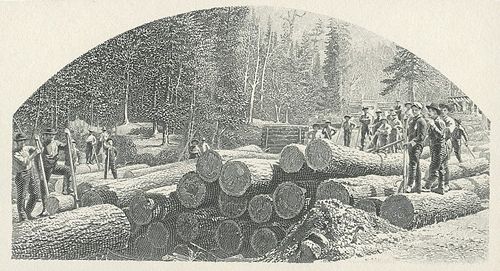 The same scene is found on the Canadian Bank of Ottawa 5 dollars note from 1906 (Charlton 565-20-06).
The same scene is found on the Canadian Bank of Ottawa 5 dollars note from 1906 (Charlton 565-20-06).
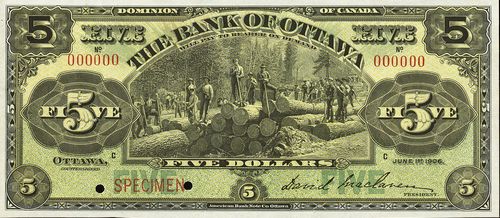
Bank of Ottawa $5
The later issues from 1913 (Charlton 565-22-02 and 565-26-02) feature a similar scene with the bottom row of logs removed, possibly to avoid cluttering a smaller vignette space than the 1906 issue. However, for the Chihuahua note, ABNC designers removed six loggers that were standing on the log pile. On the bromide, this was achieved by pasting the reworked scene directly over the original vignette.
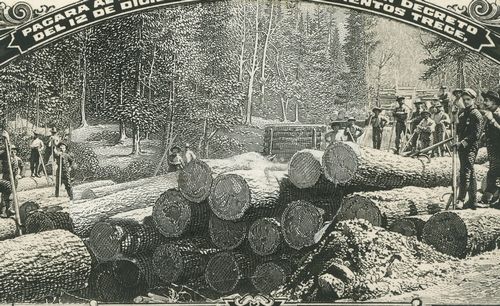
Why this change was made is unknown, though it is possible that the six loggers, who are white, looked out of place on what was to become a Mexican bank note.
The $5 note had a central vignette of a miner.
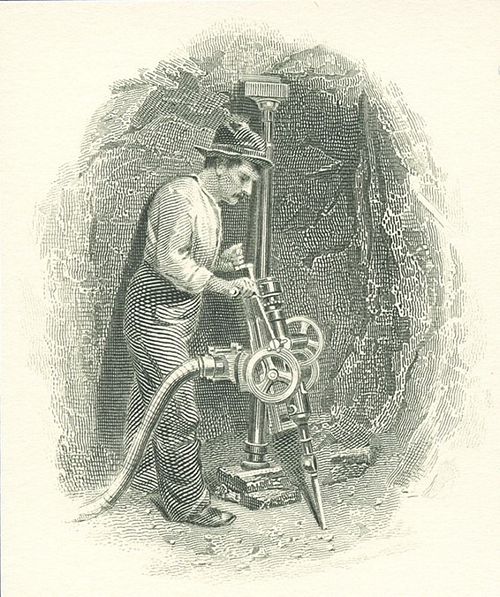
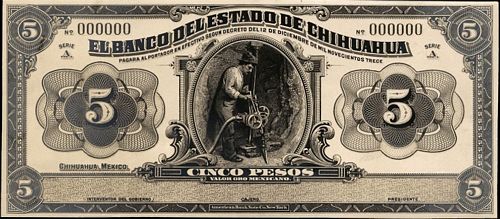
The $5 bromide displays a valuation stating VALOR ORO MEXICANO, but by 1 October, this was changed to VALOR ORO NACIONAL, as seen on the rest of the bromides as well as the finished printed notes.

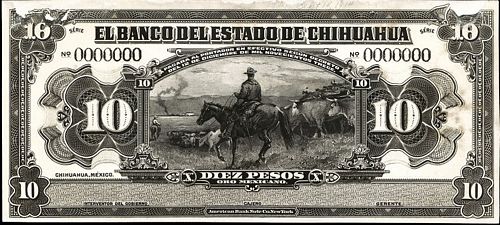
The $10 bromide has no series and the valuation read ORO MEXICANO. The vignette of a rancher driving cattle is also used on the Banco de Venezuela’s 20 bolívares, (SCWPM-S286, S291, S301, and S311, 1910-1936). The obverse has the printer’s annotation “5727 Sept 14, 1914” and the reverse “5927 Sept 14, 1914”.
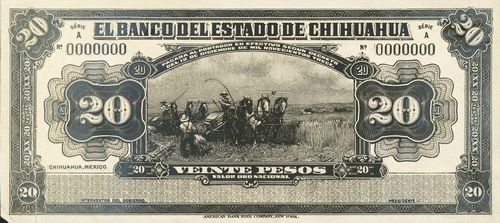 M97p2 $20 Banco del Estado de Chihuahua bromide proof
M97p2 $20 Banco del Estado de Chihuahua bromide proof
The harvest scene on the $20 note is used for the Union Bank of Canada 5 dollars, 1903-1912, (SCWPM-S1493 and S1495), and Republique d’Haiti, 1 gourde, 1914, (SCWPM-131).
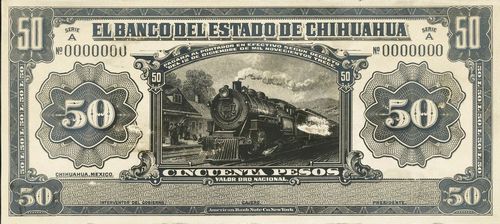 M98p2 $50 Banco del Estado de Chihuahua bromide proof
M98p2 $50 Banco del Estado de Chihuahua bromide proof
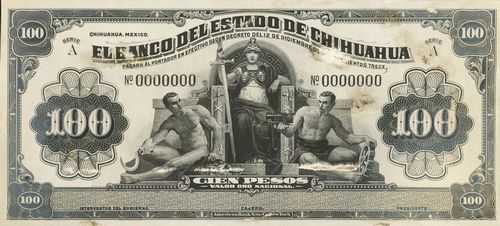 M99p2 $100 Banco del Estado de Chihuahua bromide proof
M99p2 $100 Banco del Estado de Chihuahua bromide proof
The $100 bromide depicts an armored Ceres seated with two men representing agriculture and industry in front.
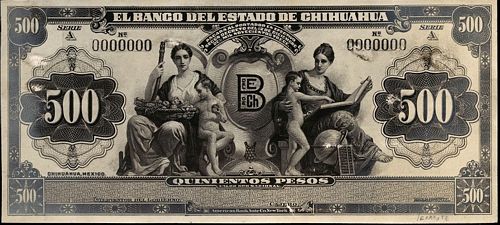
The $500 note features an allegorical design of two women, “Work” and “Knowledge,” with two young boys and El Banco del Estado de Chihuahua’s monogram in the centre. Above the central vignette, a banner with the decree date reads PAGARA AL PORTADOR EN EFECTIVO SEGÚN DECRETO DEL 12 DE DICIEMBRE DEL MIL NOVECIENTOS TRECE. The second “DEL” should be “DE”; the ABNC designers realized this and greyed out the erroneous “L.”
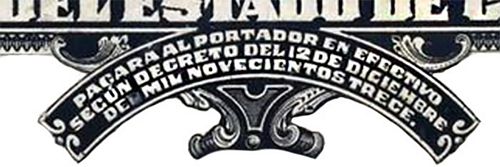
On the printed notes, the sentence reads correctly and the letters are slightly shifted to fill in the space.
Another design change on the $500 note is the change in signatories. Spaces are available for the Interventor del Gobierno (government controller), the Cajero (cashier), and the Presidente (president of the bank); however, Presidente is crossed out and Gerente (manager) is written below. All printed notes display Gerente printed in place of Presidente.
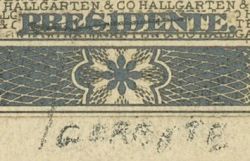
The ABNC regularly added marks to foil counterfeiters to its plates, of which we naturally usually know nothing. However, for the $10 plate we know that it broke a couple of lines in the multicolour lithowork.
ABNC was in correspondence with its agency in Mexico City, and on 6 October Charles Blackmore, the Resident Agent, wrote to say that he noted that they had received an order for the Banco del Estado de Chihuahua from Lázaro de la Garza and asked whether he was the same gentleman from whom they had refused an order for printing notes for a re-issue of bank notes for the State of Chihuahua. Blackmore wanted to know if de la Garza gave any information as to whether his bank would take the place of the Banco Minero de ChihuahuaABNC papers, folder unnumbered, Banco del Estado de Chihuahua (1914-1939).
On 7 October 1914 ABNC confirmedLG papers, 4-A-5, letter from ABNC, New York, to de la Garza, New York that the quantities had been changed to
| Quantity | from | to | Total value | |
|---|---|---|---|---|
| $1 | 1,000,000 | 000001 | 1000000 | 1,000,000 |
| $5 | 400,000 | 000001 | 400000 | 2,000,000 |
| $10 | 200,000 | 000001 | 200000 | 2,000,000 |
| $20 | 100,000 | 000001 | 100000 | 2,000,000 |
| $50 | 20,000 | 000001 | 20000 | 1,000,000 |
| $100 | 10,000 | 000001 | 10000 | 1,000,000 |
| $500 | 2,000 | 000001 | 2000 | 1,000,000 |
| 1,732,000 | 10,000,000 |
but the next day de la Garza asked ABNC not to print the $500 until he had received the board’s agreement to the changes to the number of $1 and $500 notes.
In November Lázaro de la Garza was in Torreón so on 8 November he authorized Raymondo Navarro and his nephew, Servando de la Garza, to approve the work, when the die proofs were ready. On 7 November 1914 the first die proof was ready for approvalLG papers, 4-A-19, letter from ABNC, New York, to S. C. de la Garza, Washington; by 12 November the face and back of the $10 and face of the $5 were approvedLG papers, 4-A-28, letter from ABNC, New York, to S. C. de la Garza, Washington; LG papers, 2-F-41, letter from S. C. de la Garza, Washington, to L. de la Garza, El Paso. 18 November 1914. They were approved by S. C. de la Garza: Navarro could not go as had to remain in Washington to make a consignment., and on 30 November die proofs of $20, $50, $100 back and $20 face were readyLG papers, 4-A-36, letter from ABNC, New York, to S. C. de la Garza, Washington. On 11 December since José F. Farias was in New York, he was authorized to approve the last three die proofs, but was still waiting instructions for the number of $500 notesLG papers, 4-A-41, letter from ABNC, New York, to L. de la Garza, El Paso. The ABNC proofs and specimens are dated: $10 dated 23 September 1914; $5 dated 1 October 1914; $20, $50 and $100 dated 14 October 1914; $500 dated 12 January 1915. On 5 January 1915 de la Garza told the ABNC to go ahead with the $500 notes. On 28 January 1915 he asked the ABNC to prepare the necessary plates for $1 notes of this Bank as per the designs he had already approved.
On 2 January 1915 Farias reported to de la Garza that five denominations were being printed, but that the $500 was delayed until he had confirmationLG papers, 4-G-14, letter from Farias, New York, to de la Garza, El Paso. De la Garza wanted to get his board’s consent to print $1 notes out of the amount originally allotted for the $500LG papers, 4-A-6, letter from de la Garza, New York, to ABNC, New York but on 13 January ABNC wrote to confirm the order of 5 January for 4,000 $500 notesLG papers, 4-A-1, letter from ABNC, New York, to de la Garza, El Paso, numbered 0001-4000, Serie A, delivered in sheets of 4 notes each.
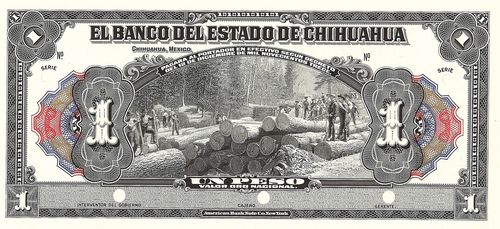
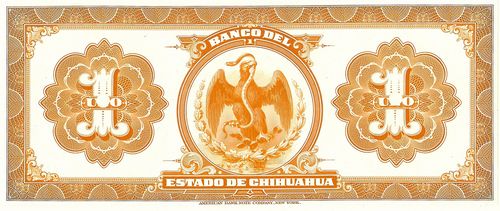
De la Garza ordered the plates for the one peso in a letter to the ABNC dated 28 January 1915. On 1 February the ABNC was ordered to make the $1 platesLG papers, 2-A-8, letter from Farias, New York, to de la Garza, El Paso. On 21 February de la Garza told the ABNC that when the bank was ready for the $1 notes it would probably order 1,000,000 notes, so the company began to prepare plates.ABNC papers, letter ABNC to de la Garza, El Paso, 26 February 1915 and on 26 February it reported that it had started preparing the plates and were awaiting instructionsLG papers, 4-B-42.
The single signature printed on the plates was that of the cajero Eugenio Soulé.
| Eugenio Soulé | 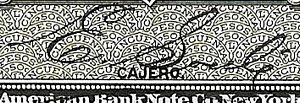 |
The final printing details are as follows:
| Date | Value | Number | Series | from | to |
|---|---|---|---|---|---|
| September 1914 | $5 | 400,000 | A | 0001 | 400000 |
| $10 | 200,000 | A | 0001 | 200000 | |
| October 1914 | $20 | 100,000 | A | 0001 | 100000 |
| $50 | 20,000 | A | 0001 | 20000 | |
| $100 | 10,000 | A | 0001 | 10000 | |
| January 1915 | $500 | 4,000 | A | 0001 | 4000 |
Consignments
The consignments, via Wells Fargo, to the Rio Grande Valley Bank & Trust Co., in El Paso, were made as follows:
| Date sent | delivered | Box no. | from | to | |||
|---|---|---|---|---|---|---|---|
| 24 December 1914 | 29 December 1914On 6 January 1915 Lázaro de la Garza asked the Rio Grande Valley Bank & Trust to hand over these notes to Félix Tibblier (LG papers, 3-J-1, letter L. de la Garza, El Paso, to Rio Grande Valley Bank & Trust Co., El Paso. 6 January 1915) | 2 | $10 | A | 000001 | 032000 | 32,000 |
| 11 January 1915 | 3 | $10 | A | 032001 | 072000 | 40,000 | |
| 4 | $10 | A | 072001 | 112000 | 40,000 | ||
| 5 | $10 | A | 112001 | 152000 | 40,000 | ||
| 6 | $10 | A | 152001 | 168000 | 18,000 | ||
| $10 | A | 168001 | 192000 | 24,000 | |||
| 7 | $10 | A | 192001 | 200000 | 8,000 | ||
| $5 | A | 000001 | 024000 | 24,000 | |||
| 14 January | 8 | $5 | A | 024001 | 072000 | 48,000 | |
| 9 | $5 | A | 072001 | 120000 | 48,000 | ||
| 25 January | 10 | $5 | A | 120001 | 160000 | 40,000 | |
| 11 | $5 | A | 160001 | 200000 | 40,000 | ||
| 12 | $5 | A | 200001 | 240000 | 40,000 | ||
| 13 | $5 | A | 240001 | 272000 | 32,000 | ||
| $50 | A | 00001 | 08000 | 8,000 | |||
| 29 January | 14 | $5 | A | 272001 | 312000 | 40,000 | |
| 15 | $5 | A | 312001 | 352000 | 40,000 | ||
| 16 | $5 | A | 352001 | 400000 | 48,000 | ||
| 17 | $20 | A | 000001 | 036000 | 36,000 | ||
| $50 | A | 008001 | 020000 | 12,000 | |||
| 3 February | 18 | $20 | A | 036001 | 100000 | 64,000 | |
| $100 | A | 00001 | 10000 | 10,000 | |||
| 18 February | 23 February | 19 | $500 | A | 0001 | 4000 | 4,000 |
On 5 March E. N. Gibbs of the ABNC, who was in Chihuahua, wrote that he had called a number of times at the Banco del Estado and met both Moye, the president, and Fifa, the manager. “The cases containing the notes we made are all in the vaults but, with the exception of one case, have not yet been opened. They tell me they are in no hurry to issue the notes yet and do not intend to until they have the corresponding equivalent in gold. Judging from the condition of the country it will be some time before they do!!” He added that “there was a directors meeting yesterday and it was decided to make no 1 Peso notes yet and I don’t think we’ll get a printing order for that denomination for some time”. Finally, he asked the ABNC to write to Sebastian Vargas and “give him all the dates on which we received money from de la Garza on behalf of the bank. I don’t know why all this is wanted but suspect our friend in El Paso is in hot water. Vargas is a director of the bank and fully entitled to this information”ABNC papers, folder unnumbered, Banco del Estado de Chihuahua (1914-1939).
De la Garza obviously did have some dispute with the bank, as on 9 June he wrote to the ABNC asking for a copy of the original authorization of the Government of the State of Chihuahua or from General Francisco Villa authorizing the manufacture for the banknotes ordered for the Banco del Estado de Chihuahua, as well as copies of all the correspondence regarding this from the Bank or Government. ABNC responded on 23 June, sending him a copy of the authorization, together with copies of correspondence they had had with Messrs. Flint & Co. and de la Garza himself with reference to these notes.
On 23 June the bank wrote that they had recently received 17 boxes of notes but were missing the 4,000 $500 notes and asked the ABNC for details of the shipment. On 29 June the ABNC replied that box 19, containing the missing notes, had been delivered on 23 February to Mr. Rosenfeld, the Assistant Cashier of the Rio Grande Valley Bank & Trust Co. of El Paso.
So the American Bank Note Company notes never reached circulation: certain references, however, suggest that Villa always did mean to issue the notes and it was only his loss of control of Chihuahua that prevented it. Thus on 17 June Vida Nueva reported that the new notes, totaling $5m, would probably be put into circulation the next day at a rate of 50c goldVida Nueva, 17 June 1915 and in August 1915 it was reported from El Paso that the Villistas were going to issue a series of notes showing the American flagEl Democrata, Monterrey, 14 August 1915. The reference to the design was probably a piece of black propaganda.
On 2 February 1916 the ABNC recorded that it had put the plates and dies in its vault and closed the orderABNC papers, folder unnumbered, Banco del Estado de Chihuahua (1914-1939).
Bearer cheques
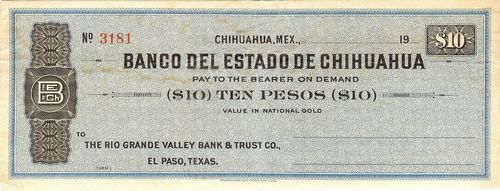
| from | to | total number |
total value |
||
| $10 | 1 | 5000 | 5,000 | $ 50,000 | includes number 3181 |
| $20 | 1 | 5000 | 5,000 | 100,000 |
In October 1914 the bank also produced 5,000 $10 bearer cheques and 5,000 $20 bearer cheques[image needed] drawn on the Rio Grande Valley Bank & Trust Co., El PasoLG papers, 4-A-8. The cheques were printed in English with the instruction to pay to the bearer on demand TEN or TWENTY PESOS VALUE IN NATIONAL GOLD.
On 30 October the ABNC forwarded to the bank, care of the Rio Grande Valley Bank & Trust Co., El Paso, a box containing 5,000 $10 cheques, numbered 1 to 5000, and 5,000 $20 cheques, also numbered 1 to 5000.

